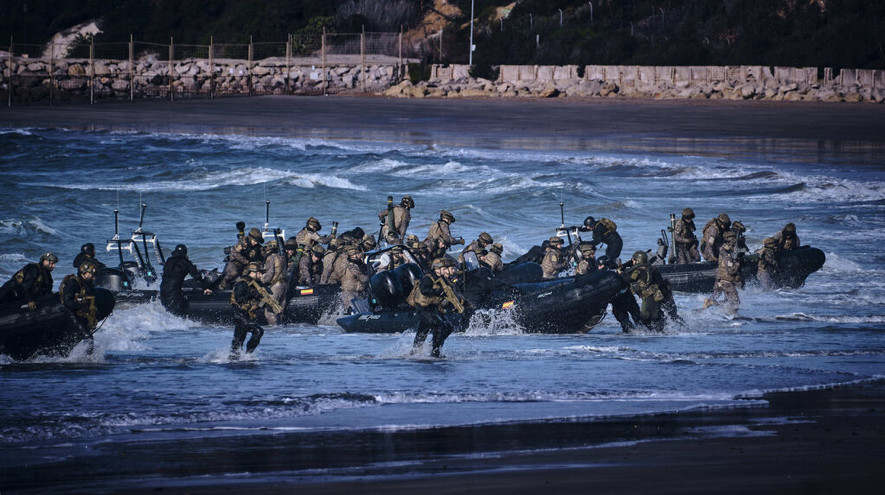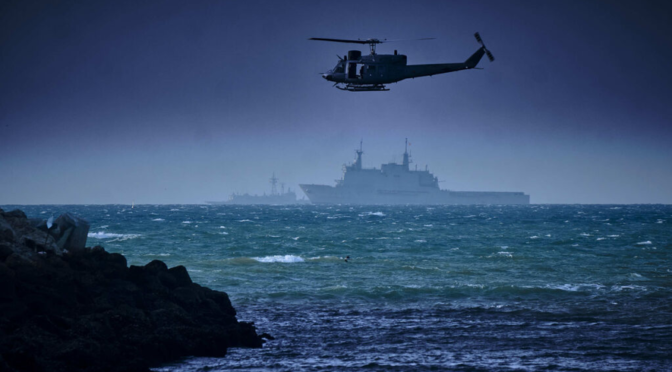By Gonzalo Vázquez
The EU’s Crisis Management Military Exercise 23 (MILEX 23) was launched on September 18, 2023, at the Military Planning and Conduct Capability (MPCC) Operations Headquarters in Brussels. Unlike any previous exercise, it was conducted in two different phases: a command post exercise (CPX) testing the military planning process at the strategic and operational levels, and a live exercise (LIVEX) carried out in the coast of Cadiz (Spain) simulating “realistic crisis events” with naval elements, land components, and air, space, and cyber assets.
The second phase, which took place from October 16th until the 22nd, put in practice for the first time the scenario developed in the previous phase, and was coordinated at three different levels: an EU Operational Headquarters provided by the MPCC (strategic level), an EU Force Headquarters provided by the Spanish Armed Forces in the naval base of Rota (operational level), and a battlegroup-sized force provided by Spain with additional military units of other member states (tactical level). The latter included a total of 31 units, 25 aircraft, 6 ships, and 2,800 personnel deployed in the theater of operations.
Under the command of Spanish Rear Admiral Gonzalo Villar, the LIVEX was conducted in four different segments: preparing for the operation; conducting an amphibious assault led by the expeditionary unit of the Spanish Navy; establishing control and securing the seaport of debarkation; and inserting land forces to secure the target area of interest. The Spanish Navy’s assets involved were those of the Expeditionary Unit “Dedalo-23,” including the “L-61 Juan Carlos I” LHD, Galicia-class LPDs “L-51 Galicia” and “L-52 Castilla,” Santa María-class FFG “F-83 Numancia,” several AV-8B Harrier II aircraft and helicopters, and an Amphibious Expeditionary Unit (with the Navy´s “Infantería de Marina”). Days before the exercise, these units had also conducted a bilateral exercise with the USS Mesa Verde (LPD-9).
The exercise’s main objective is “to enhance the EU’s military readiness to respond to external conflicts and crises.” It is a relevant step for the EU as it prepares for the establishment of its Rapid Deployment Capacity (EU RDC), a crucial instrument that will allow its members to provide timely and effective responses to any potential crisis. It comes at a time when the ongoing conflicts in Eastern Europe and the Middle East are challenging the stability in the Black Sea and Eastern Mediterranean regions.
MILEX 23 will go down in history as the first ever to include a LIVEX led by the European Union, in which 19 member states have demonstrated their willingness to strengthen their security ties and naval interoperability. The exercise’s objectives derive from those established in the Strategic Compass of 2022, and are expected to be followed by those in the EU Maritime Security Strategy. Both documents define the strategic objectives for EU members, including those related to naval capabilities and maritime security.
European Naval Ambitions: The Strategic Compass & the EUMSS
The Strategic Compass was published in 2022 immediately after the outbreak of the war in Ukraine. It came as a direct response to the perceived return of power politics in “a contested multipolar world,” and an increasingly challenging strategic environment. It provides the EU and its members with a direction to follow as they strive to adapt their military capabilities and security policies to the current situation. Its focus on the maritime domain emphasizes the growing competition at sea by stating:
“With the maritime domain becoming increasingly contested, we commit to further asserting our interests at sea and enhancing the EU’s and Member States’ maritime security, including by improving the interoperability of our naval forces through live exercises and by organizing European port calls.”
It stresses the need for regular naval exercises with European navies and coast guards as a means to strengthen interoperability among them. MILEX 23, although coming later than initially desired, marks an important step towards the establishment of its Rapid Deployable Force by 2025 – which is expected to have an important naval component.
Following the Strategic Compass, the EU published in March 2023 the updated version of its Maritime Security Strategy (EUMSS), although, as the document itself states, it is not a proper strategy but rather “a framework for the EU to take further action.” The document, officially ratified by the EU Council on October 25th, addresses some of the concerns already defined in the Strategic Compass such as the need “to secure the maritime security interests of the EU and its member states against a plethora of risks and threats in the global maritime domain.”
To enhance naval interoperability among its members, the EUMSS highlights the importance of its ongoing naval operations (“Atalanta” and “Irini”), and defines several “key actions” to be pursued, including “organizing an annual EU naval exercise” and “reinforcing existing EU naval operations with naval and air assets.” Adding to the annual exercise, it also pushes for “regular, full-scale, live exercises at EU level.” LIVEX 23, as part of MILEX 23, has been the first of them, and is set to be followed by more over the upcoming months and years.
In broad terms, both the Strategic Compass and the EUMSS offer valuable insights on European ambitions at sea, but member states will have to get serious upgrading their naval capabilities to ensure those aspirations can be attained. MILEX 23 is an important milestone for them in the EU’s quest to become a credible naval actor able to “tackle the evolving threats to [its] maritime security.”
MILEX 23: A Crucial Leap
Milex 23 is an important milestone for the EU in several ways, and a crucial leap for its members as they advance towards a cohesive and common security policy.
First and foremost, its importance lies in the lessons learned with it. It is the first exercise ever at this level to include a LIVEX, with such a level of preparation and involvement of EU assets (its preparation has taken 14 months). It is an important step, but just the first of many to come. Its lessons learned will undoubtedly enhance future iterations and allow the EU to keep building on its security architecture. As Director Military Planning and Conduct Capability (D MPCC), Lieutenant General Michiel van der Laan indicated during the iteration, “what we learn from MILEX 23 will be crucial in refining our concepts, identifying gaps, and improving operational processes.”

Second, the exercise can serve as a powerful tool to incentivize additional investments on military capabilities by EU member states, which are greatly needed at this point. Following the end of the Cold War, most EU and NATO nations significantly reduced their defense spending and shifted their defense priorities, which led to a significant shrinking of their naval capabilities. Now, with smaller navies and the emergence of a wide spectrum of threats and challenges to European security, exercises such as MILEX 23 can be a powerful tool to show national governments the importance of increasing defense spending as a means to secure our common interests. As underlined by Daniel Fiott a few years ago, “Europe’s navies are increasingly being called upon to perform maritime security tasks,” which will require national governments to increase their investments in sea power. Joint exercises with a clear purpose can bring positive results for both their national and common security interests.
As already mentioned, the exercise is expected to be followed by others on a more regular basis. Aside from the objectives set in the Strategic Compass in terms of military readiness, the above-discussed EUMSS will ensure that EU members conduct at least an annual naval exercise. These can yield positive results for participating navies, but will require the EU to clearly define its naval/maritime priorities, and then plan the exercises calendar according to those requirements. To do so, the EU will have to keep working on a maritime strategy that clearly defines the ways, means, and ends, which the 2023 update of the EUMSS did not fully achieve.
Lastly, MILEX 23 can be regarded as another step in the EU’s quest to bolster interoperability with partner nations beyond its borders. As underlined in the EUMSS and other relevant policy documents published during the last few years, there is a great strategic interest in the Indo-Pacific region. Strengthening interoperability among member states will allow the EU to keep building upon its cooperation with partners such as the U.S. or Indian navies, with which they have already conducted multilateral naval exercises.
Yet, as the EU moves forward during the following years carrying out other joint exercises, another critical consideration related to the above-discussed need for a real maritime strategy will gradually surface: the need to avoid duplicity of efforts between NATO and the EU. Most EU navies are also part of the Atlantic Alliance, and as such, they contribute to both. Thus, at a time when military budgets are not abundant, exploring ways to define a clear division of naval tasks between the two organizations will be crucial to maximize their individual contributions and avoid wasting efforts.
Gonzalo Vázquez is a junior analyst with the Center for Naval Thought at the Spanish Naval War College, and is currently working as an Intern at the Crisis Management and Disaster Response Center of Excellence in Sofia, Bulgaria. Views expressed are his own.
Featured Image: Naval forces during the exercise off the coast of Cadiz, Spain (Photo via Julio González/Diario de Cádiz)


To whom this may concern my name is clarencewalker336@gmail.com 4694075587